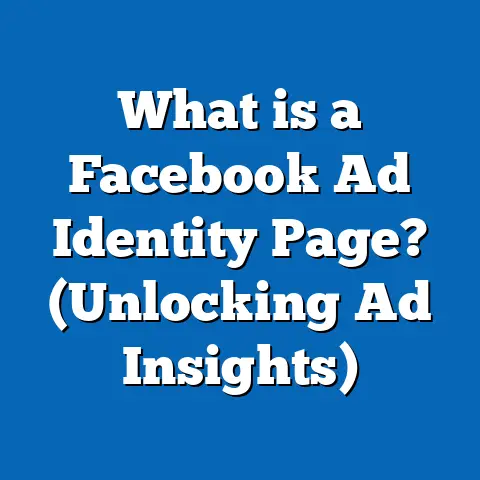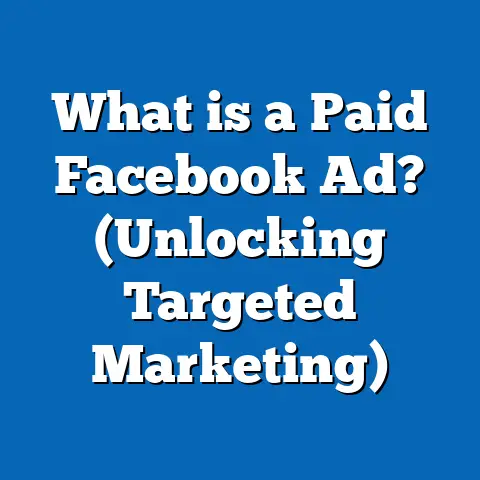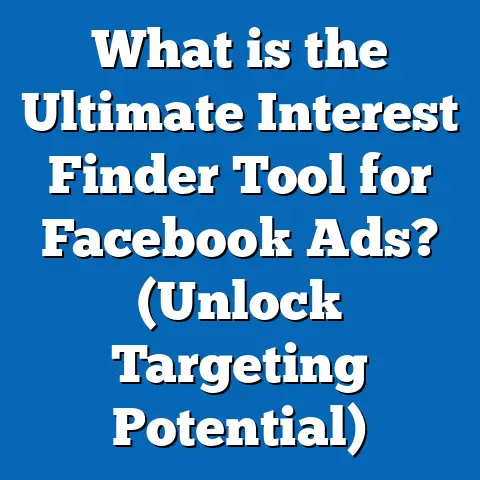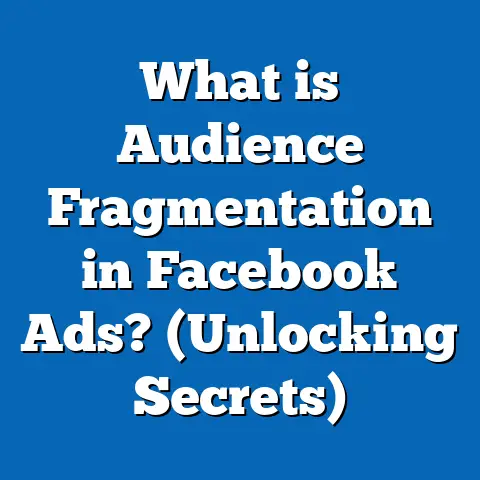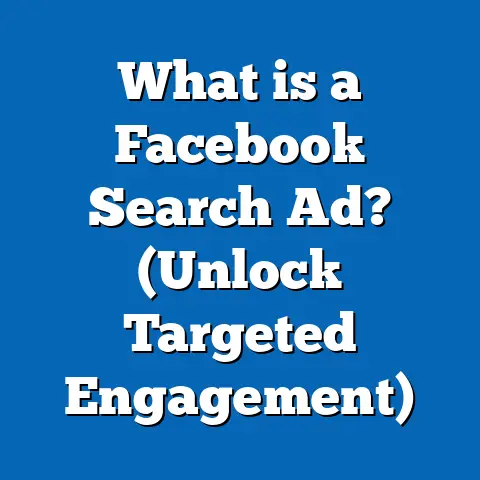What is a Good Facebook Ad Budget? (Secrets for Success)
What Is a Good Facebook Ad Budget? (Secrets for Success)
Introduction: The Ease of Adjusting Your Facebook Ad Budget
One of the strongest advantages of advertising on Facebook is the incredible ease with which you can modify your ad budget. Unlike traditional advertising channels where budgets are often locked in months ahead, Facebook allows advertisers to start small, gauge performance, and increase or decrease spending in real-time. This flexibility means you don’t have to risk large sums upfront. Instead, you can optimize your budget dynamically based on actual results.
But how do you determine what a “good” Facebook ad budget really is? What should you spend to get meaningful results without overspending? The answer depends on many factors — your business goals, the size and nature of your target audience, industry benchmarks, and your campaign objectives.
Understanding Facebook Ad Budgets: The Basics
What Is a Facebook Ad Budget?
Your Facebook ad budget is the total amount of money you allocate for running ads on Facebook over a period of time. When creating campaigns, Facebook gives you two budget options:
- Daily Budget: The average amount you want to spend each day.
- Lifetime Budget: The total amount you want to spend over the entire campaign duration.
Choosing between daily and lifetime budgets depends on how much control and flexibility you want over spending patterns.
Why Setting the Right Budget Matters
Your budget directly influences:
- How many people your ads reach
- How often your ads are shown (frequency)
- How quickly you gather data for optimization
- The effectiveness of Facebook’s algorithm in delivering results
- Your overall return on ad spend (ROAS)
If your budget is too low, Facebook’s algorithm may struggle to optimize ad delivery effectively or generate enough data to identify winning audiences and creatives. Too high a budget without proper strategy can lead to wasted spend.
Key Factors Determining a Good Facebook Ad Budget
1. Define Clear Business Goals
Your budget should start with your business goals as the foundation.
- Brand awareness: If your goal is to build brand recognition or reach a broad audience, you’ll generally need a higher budget to get enough impressions.
- Lead generation or conversions: Here, the budget depends on your expected cost per lead (CPL) or cost per acquisition (CPA). You want to invest enough to capture quality leads while keeping costs manageable.
- Engagement (likes, comments, shares): This usually requires less budget per action but can be an intermediate step in your funnel.
- App installs or video views: These often have lower costs per action but require careful targeting.
2. Audience Size and Targeting
Your audience size heavily influences budget needs.
- Small audiences (under 100,000 people): Lower budgets can work because you’re targeting fewer people. But too low a budget may cause audience fatigue quickly.
- Medium to large audiences (100,000+): These require higher budgets to generate meaningful insights and avoid under-delivery.
- Broad targeting: Requires larger budgets because of the volume.
- Narrow targeting: Might be more cost-effective but requires precise messaging.
3. Industry Benchmarks: What Does Advertising Cost?
Knowing average costs helps set realistic expectations and budgets.
| Industry | Average CPM* | Average CPC* | Average CPA* |
|---|---|---|---|
| E-commerce | $7 – $12 | $0.70 – $1.00 | $10 – $25 |
| Finance | $10 – $20 | $1.50 – $3.00 | $30 – $70 |
| Health & Fitness | $5 – $10 | $0.50 – $1.20 | $12 – $30 |
| B2B | $8 – $15 | $1.20 – $2.50 | $40 – $100 |
*CPM = Cost Per 1,000 Impressions
*CPC = Cost Per Click
*CPA = Cost Per Acquisition (sale/lead)
(Source: WordStream 2024 Facebook Ads Benchmarks)
How Much Should You Start With?
Small Businesses and Startups
For startups or small businesses new to Facebook ads:
- Recommended starting daily budget: $5 – $20
- Purpose: Test different creatives, audiences, and messaging.
- Benefit: Low risk while gathering initial performance data.
- Expectation: Limited reach but valuable learning.
Medium-Sized Businesses
For businesses with some online presence and sales history:
- Starting daily budget: $20 – $100
- Purpose: Test multiple campaigns simultaneously.
- Benefit: Faster data gathering for optimization.
- Expectation: Ability to refine audiences and creatives based on solid data.
Large Enterprises
For brands with established marketing teams and larger sales volumes:
- Starting daily budget: $100+
- Purpose: Run multi-campaign strategies including retargeting, prospecting, and brand awareness.
- Benefit: Rapid scaling and testing of advanced tactics.
- Expectation: Higher volume sales and leads with detailed analytics.
Case Study #1: Scaling an E-commerce Brand from $10 to $1,000 Daily Budget
Company: Trendy Apparel Co., a niche online fashion retailer
Objective: Increase online sales through Facebook ads
Initial Budget: $10/day
Phase 1 – Testing ($10/day for 14 days)
- Tested 3 different ad creatives featuring products.
- Targeted broad interests related to fashion trends.
- Results:
- CTR: 2%
- CPC: $0.85
- CPA: $15 (sales)
- Total sales generated: 10 sales
Phase 2 – Refinement & Scaling ($50/day for 21 days)
- Created lookalike audiences based on past purchasers.
- Added video ads showcasing product features.
- Introduced retargeting campaigns for website visitors.
- Results:
- CTR increased to 3.2%
- CPC dropped to $0.70
- CPA improved to $12
- Total sales generated: 75 sales
Phase 3 – Advanced Scaling ($200/day ongoing)
- Used Campaign Budget Optimization (CBO) across multiple ad sets.
- Employed dynamic ads for personalized product recommendations.
- Split-tested landing pages for conversion rate optimization.
- Results:
- CTR stabilized at 3.5%
- CPC dropped further to $0.60
- CPA reduced to $9
- Weekly sales increased to 250+
- ROAS averaged 4x
Key Insight: Gradual budget increases paired with continuous optimization lowered costs and boosted sales dramatically.
How Does Facebook Allocate Your Budget?
Understanding Facebook’s ad auction system helps explain why budget matters.
Facebook runs an auction every time there’s an opportunity to show an ad. Your budget influences:
- Bid competitiveness: Higher budgets allow more bids and better ad delivery.
- Learning phase: Facebook’s algorithm needs sufficient budget to gather data and optimize.
Facebook recommends a minimum spend of about $20-$50 daily per campaign for effective learning and delivery.
Advanced Budgeting Techniques For Better Results
Campaign Budget Optimization (CBO)
With CBO, you set one campaign-level budget that Facebook automatically distributes across ad sets based on performance.
Pros:
- Saves time managing individual budgets.
- Maximizes overall campaign efficiency.
Cons:
- Requires minimum budgets (~$50+ daily).
- Less control over individual ad set spend.
Bid Strategies and Cost Controls
Choose between:
- Lowest cost bidding: Facebook tries to get the most results at the lowest cost within your budget.
- Bid cap: Sets a maximum bid amount, controlling maximum cost per result.
- Cost cap: Keeps costs around a specific target while maximizing volume.
Using bid caps is useful when you have strict cost limits but can reduce delivery volume if set too low.
Automated Rules
Set rules that automatically:
- Increase budgets for high-performing ads.
- Pause underperforming ads.
This keeps your campaigns optimized without constant manual monitoring.
Comparing Facebook Ad Budgets with Other Platforms
| Platform | Minimum Daily Budget | Average CPC | Audience Targeting Strength | Best For |
|---|---|---|---|---|
| $1 | $0.50 – $1.50 | Highly granular interest-based | B2C, brand awareness, direct response | |
| Google Ads | ~$10-$20 | $1.00 – $2+ | Intent-based search targeting | High intent searches |
| LinkedIn Ads | ~$10-$25 | $5 – $8 | Professional B2B targeting | B2B lead generation |
| Instagram Ads | Follows Facebook | Similar to Facebook | Visual-first; influencer-driven | Engaging visual campaigns |
Facebook offers highly cost-effective targeting with flexible budgeting suitable for both B2C and B2B markets.
Practical Framework for Setting Your Facebook Ad Budget
Using these steps can make budgeting decisions easier:
Step 1: Calculate Your Customer Value Metrics
Understand your:
- Average Order Value (AOV): How much does a typical customer spend?
- Customer Lifetime Value (CLV or LTV): How much revenue does a customer generate over their relationship?
Step 2: Set Your Target Cost per Acquisition (CPA)
Determine the maximum CPA you can afford while maintaining profitability: Target CPA=Profit Margin×AOV\text{Target CPA} = \text{Profit Margin} \times \text{AOV}
For example, if profit margin is 30% on a $100 order: Target CPA=0.30×100=$30\text{Target CPA} = 0.30 \times 100 = \$30
Step 3: Estimate Initial Daily Budget Based on Target Volume
Decide how many new customers or leads you want daily: Daily Budget=Target CPA×Desired Daily Conversions\text{Daily Budget} = \text{Target CPA} \times \text{Desired Daily Conversions}
If aiming for 5 customers daily at a CPA of $30: 5×$30=$150 daily budget5 \times \$30 = \$150 \text{ daily budget}
Step 4: Start Testing at Lower Budgets
Begin at about 30%-50% of estimated daily budget for testing before scaling.
Step 5: Continuously Optimize and Scale
Use performance data to adjust budgets upward by increments of 20%-30% every few days for smooth scaling.
Deep Dive: Impact of Audience Size on Budget
Small Audiences (<100k People)
Good for retargeting warm leads or niche products.
Budget tip: Set budgets between $5-$20/day per campaign; higher might cause audience fatigue quickly due to limited reach.
Medium Audiences (100k – 500k People)
Ideal for lookalike audiences or focused interest groups.
Budget tip: Budgets between $20-$100/day allow effective testing and delivery without overexposure.
Large Audiences (>500k People)
Best for broad awareness campaigns or brands with mass appeal.
Budget tip: Daily budgets above $100 are needed to get consistent results and gather enough data quickly.
Importance of Campaign Duration in Budget Planning
The length of your campaign affects how your budget should be allocated:
| Campaign Duration | Budgeting Advice |
|---|---|
| Short-term (<7 days) | Higher daily budgets needed; urgency-based targeting works well. |
| Medium-term (2-4 weeks) | Moderate daily budgets with frequent optimization cycles. |
| Long-term (1+ months) | Lower daily budgets sustained over time; focus on brand building and retargeting. |
Longer campaigns allow more gradual spending and optimization but require patience for results.
Common Mistakes in Facebook Ad Budgeting and How to Avoid Them
| Mistake | Explanation | How To Avoid |
|---|---|---|
| Setting budgets too low | Limits data collection; algorithm can’t optimize well. | Start with at least $5-$10/day even for tests. |
| Increasing budgets too fast | Shocks the algorithm causing instability | Increase budgets by max 20%-30% every few days |
| Not tracking key metrics | Can’t measure effectiveness | Use Facebook Ads Manager & Google Analytics regularly |
| Over-targeting small audiences | Leads to audience fatigue & rising costs | Expand targeting slightly or use frequency caps |
| Ignoring frequency | High frequency causes ad fatigue | Keep frequency below 3; refresh creatives regularly |
Real World Example #2: Lead Generation Campaign for B2B SaaS Company
Company: TechSolutions Inc., SaaS platform for project management
Goal: Generate high-quality leads via Facebook Lead Ads
Initial Budget: $25/day
Campaign Setup
- Targeted lookalike audiences from existing customers
- Created lead magnet with free eBook offer
- Used video ads explaining product benefits
Results After One Month
| Metric | Value |
|---|---|
| Leads Generated | 320 leads |
| Average CPL | $4.50 |
| Conversion Rate | 12% |
| Cost per Customer Acquisition (CPA) after nurture | ~$45 |
Budget Insights
Started at $25/day; increased gradually to $75/day after positive CPL trends. Focused mostly on lookalike targeting with retargeting warm audiences using smaller budgets ($10/day).
Using Attribution Models To Guide Your Budget Allocation
Facebook offers several attribution models that affect how conversions are credited:
- 1-day click
- 7-day click
- 1-day view
- 7-day click & view
The choice impacts how you evaluate your CPA and ROAS — which in turn affects budgeting decisions.
For longer sales cycles, use extended attribution windows (7-day click) which may justify higher budgets as conversions occur later.
Emerging Trends Impacting Facebook Ad Budgets in 2024+
Artificial Intelligence & Machine Learning Enhancements
Facebook’s evolving AI improves ad delivery but requires sufficient budget volume for learning phases.
Privacy Changes & Data Limitations
Apple’s iOS updates (App Tracking Transparency) have raised CPCs slightly due to reduced tracking precision — meaning potentially higher budgets are needed for accurate targeting.
Video & Reels Focused Ads
Video ads now dominate engagement rates; allocating more budget


